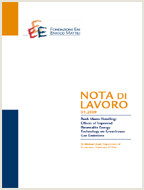Environmental and Technology Policy Options in the Electricity Sector: Interactions and Outcomes

15.07.2014
Carolyn Fischer, Richard G. Newell, Louis Preonas
Q42, Q52, Q55, Q58
Climate Change, Cap-and-Trade, Renewable Energy, Portfolio Standards, Subsidies, Spillovers, Energy Efficiency, Electricity
Climate Change and Sustainable Development
Carlo Carraro
Myriad policy measures aim to reduce greenhouse gas emissions from the electricity sector, promote generation from renewable sources, and encourage energy conservation. To what extent do innovation and energy efficiency (EE) market failures justify additional interventions when a carbon price is in place? We extend the model of Fischer and Newell (2008) with advanced and conventional renewable energy technologies and short and long-run EE investments. We incorporate both knowledge spillovers and imperfections in the demand for energy efficiency. We conclude that some technology policies, particularly correcting R&D market failures, can be useful complements to emissions pricing, but ambitious renewable targets or subsidies seem unlikely to enhance welfare when placed alongside sufficient emissions pricing. The desirability of stringent EE policies is highly sensitive to the degree of undervaluation of EE by consumers, which also has implications for policies that tend to lower electricity prices Even with multiple market failures, emissions pricing remains the single most cost-effective option for reducing emissions.
***
Suggested citation: Fischer, C., R. G. Newell, L. Preonas, (2014), ‘Environmental and Technology Policy Options in the Electricity Sector: Interactions and Outcomes’, Nota di Lavoro 67.2014, Milan, Italy: Fondazione Eni Enrico Mattei.
